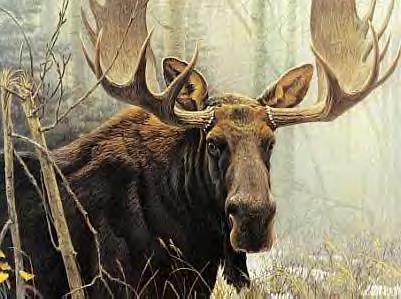|
|
Canku Ota |
|
|
(Many Paths) |
||
|
An Online Newsletter Celebrating Native America |
||
|
January 27, 2001 - Issue 28 |
||
|
|
||
|
Tribal Members Conduct Moose Census |
||
|
by Diana Graettinger of the Bangor News Staff |
||
 INDIAN
TOWNSHIP, Maine — They are the giants of the forest, and during the past week, Passamaquoddy Tribe planners had
the opportunity to see how many inhabit tribal lands. INDIAN
TOWNSHIP, Maine — They are the giants of the forest, and during the past week, Passamaquoddy Tribe planners had
the opportunity to see how many inhabit tribal lands.Wildlife biologist Joe Kemmer, along with two tribal members, went moose hunting Wednesday. But instead of guns, they were armed with notebooks and maps. Their mission was to conduct an aerial survey of the moose that range over the 23,000 acres owned by the Passamaquoddy Tribe in Washington County. For the survey, the Indian Township lands were divided into three segments. Kemmer, along with Indian Township environmental technician Matthew Dana and Dale Mitchell, a wildlife specialist at Pleasant Point, traveled along a grid pattern that stretched from Grand Falls to Patten Pond. On Thursday they returned and surveyed the last two segments, which included Tomah Springs. “Moose are an important species for the tribe and a focus species for the wildlife,” Kemmer said. “Among the questions we tried to answer were how many moose do we have, the distribution and where they are located and the sex ratio, how many males to females. It all comes down to doing better moose management by knowing what we have.” Kemmer said they saw more females than males during their two-day survey. During the first day, they spent 56 minutes in the air and saw six moose. The next day, 60 minutes of flying time revealed 22 moose. Eleven moose, the largest number spotted in a single area, were found in the Tomah Stream area. “We counted out the various age classes and the sexes,” he said. The wildlife biologists said the next step would be to apply a correction factor. He said that, with data from infrared studies conducted in Maine and New Brunswick, they would be able to extrapolate from their visual count and get a better idea of the size of the total moose herd on the reservation. “We are going to rely on those studies that use infrared for our correction factor because infrared goes through the canopy and picks up the animals,” he said. Kemmer said he had been concerned about the closed canopy the Maine forest offers and feared that they may not be able to get a significant moose count. But he said they found that the majestic animals stood out. He said the snow on the ground made the creatures, which can reach in excess of 1,000 pounds, more visible. Dana, who acted as one of the observers, said he was impressed with the exercise. “It was really enjoyable, and it was a good learning experience,” he said. Dana said the first moose they encountered stood and stared at them. A few minutes later they saw a female and her calf, which took off running. “It was exciting to see them,” he said. Although more studies will be conducted during the winter on land the tribe owns south of Springfield, Kemmer said, the Jackman area would have to wait until next year. “We are running out of time because the males are starting to lose their antlers and we won’t be able to tell the sexes. If it gets any colder and if we get more snow, they will huddle under the closed canopy and we won’t be able to see them as well,” he said. Now that the tribe has some baseline numbers, Kemmer said, the effort will become an annual study. “The important thing here is the monitoring ability. Every two or three years we’ll go out and survey, then you can look at trends and know how well our moose population is doing.” The tribe permits the harvesting of moose, and rules allow the taking of one moose per household. “For Indian Township, we’ve been averaging about 15 moose a year,” he said. Kemmer said it was too early to gauge what impact the hunt has had on the population. “We have to complete the other surveys. ... The reason why we are doing this is to see how healthy the population is,” he said. The Passamaquoddy Tribe recently conducted an aerial survey of the moose population in Indian Township. |
|
Passamaquoddy Tribe |
|
People of the Dawn-Indian
Township |
|
|
||
|
|
||
| Canku Ota is a free Newsletter celebrating Native America, its traditions and accomplishments . We do not provide subscriber or visitor names to anyone. Some articles presented in Canku Ota may contain copyright material. We have received appropriate permissions for republishing any articles. Material appearing here is distributed without profit or monetary gain to those who have expressed an interest. This is in accordance with Title 17 U.S.C. section 107. | ||
|
Canku Ota is a copyright © 2000, 2001 of Vicki Lockard and Paul Barry. |
||
|
|
The "Canku Ota - A Newsletter Celebrating Native America" web site and its design is the |
|
|
Copyright © 1999, 2000, 2001 of Paul C. Barry. |
||
|
All Rights Reserved. |
